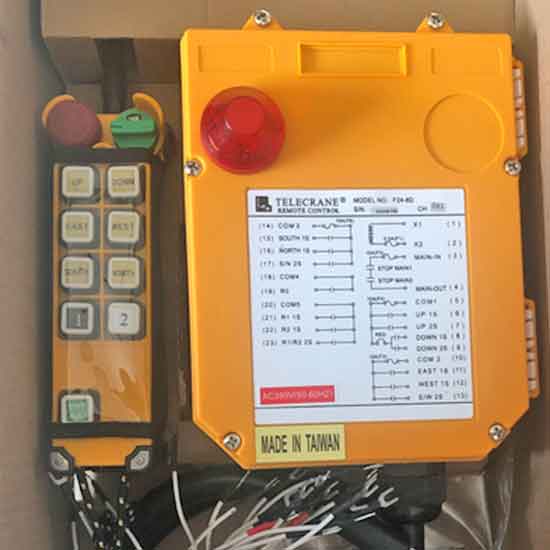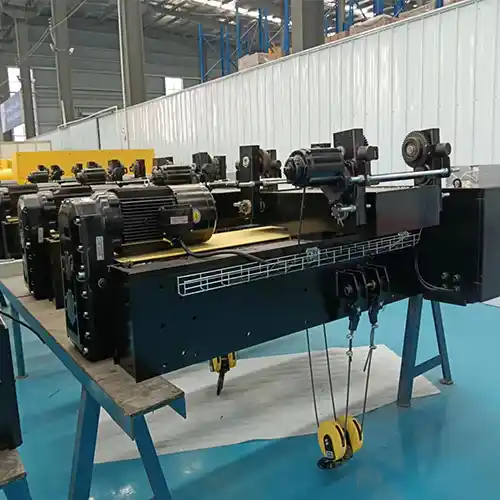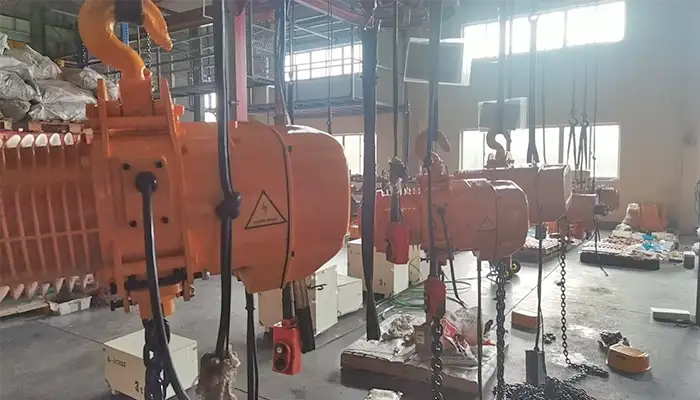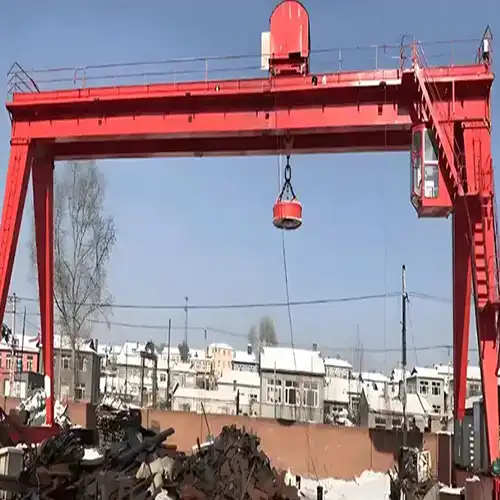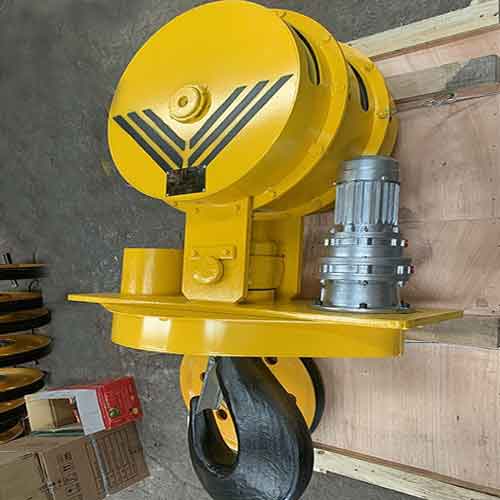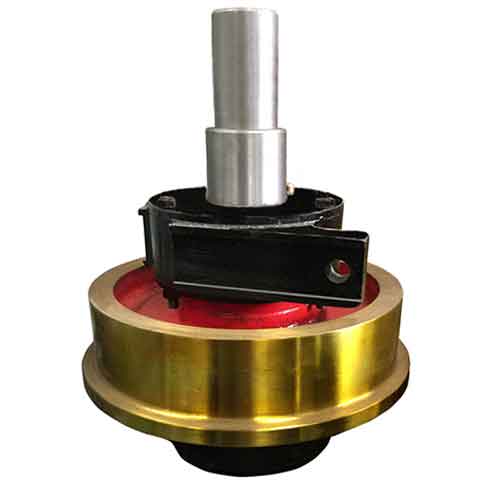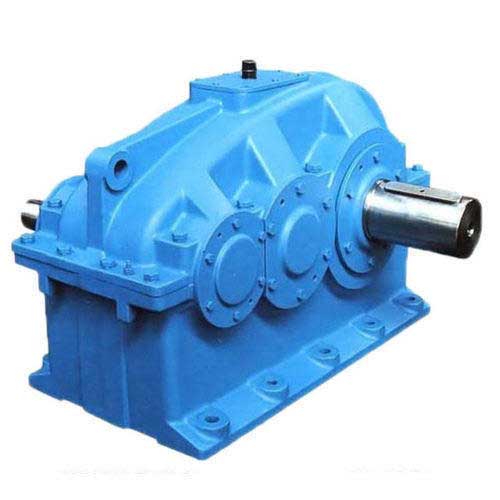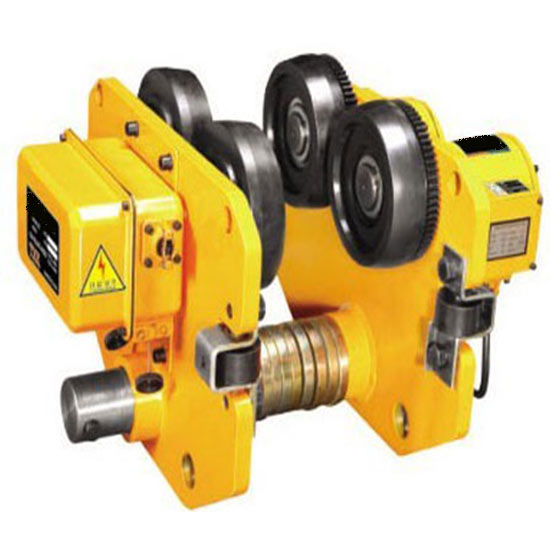Crane Remote Control & Radio Remote Control for EOT Cranes
Crane remote control, crane wireless control and radio remote control for eot cranes, Full ranges of industrial crane remote control, good radio remote control price.
| Crane part | Crane remote control |
| Crane control type | Type Push button,Rocker remote control |
| Application Temperature | -35℃ to +85℃ |
Category: Crane Kit Parts
Crane remote control, crane remote control and radio remote control for eot cranes, Full ranges of industrial crane remote control, good radio remote control price.
Radio Controls for Overhead Cranes
The transmitter and receiver are the two parts of the crane remote control. The shell is made of special technical plastic with secondary glass fiber molding, and it can withstand a substantial amount of falling impact. The IP65 rating indicates that it is waterproof, dustproof, and acid and alkali resistant.
PLL phase-locked circuit and quartz circuit are used in the wireless transmitting and receiving parts, along with security code, Hamming code, and other security measures. The automatic frequency is very low (less than 10 MW), and the distance between the transmitter and the receiver is 100-200 meters.
It offers the properties of low power consumption and excellent stability. With 4 or 2 5 alkaline cells, it can run constantly for 2-6 months. Encoding and decoding components are controlled by a self-developed CPU chip. Multiple security protections are built into the CPU and external circuit, which can instantly stop the output if the CPU or peripheral components fail. It can not only successfully reduce external interference signals, but it can also identify and stop the output immediately if an internal component breaks, substantially improving its safety and dependability.
All combinations of 6 to 12 keys are available in the new F23 / F24 series, which is separated into single speed and dual speed variants. The buttons can be increased or decreased according to the user's preferences, and the single and double speeds can be swapped.
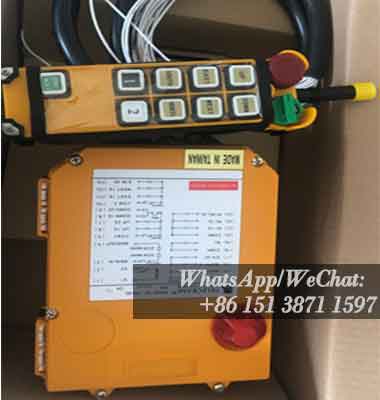
Crane remote control

Crane wireless radio control

Push button remote control
Application
A remote control device is known as an industrial crane remote control which is used to control construction machinery or industrial equipment. It is mostly utilized in industries such as metallurgy, shipbuilding, container terminals, storage, machinery manufacturing, chemical industry, papermaking, construction, fire control, and engineering machinery, among others. It has an effective control range of 100 meters in either direction and is unaffected by barriers.
To minimize the hidden threat of accidents caused by unclear vision, wire control bonding, bad surroundings, or incorrect command cooperation, the operator merely needs to carry a light transmitter, walk freely, and choose the optimal (SAFE) visual position for operation. This is to ensure a safe operation while also significantly increasing production efficiency.
Featured remote controls

F21-E1B crane remote control
Series of crane remote control : f21-9ll
Size of crane remote control : 15.6 * 6.1 * 51
Weight of crane remote control : 1.2kg
Product performance: It has 8 keys, 6 single speed keys, a retractable handle, a control distance of 100m, an IP65 protection rating, and a service temperature range of - 30°C to + 75°C, wide applications.
F21-e2s crane remote control
F21-e2s crane remote control
Size of crane remote control : 13.2 * 5.5 * 3.9
Weight of crane remote control : 0.95kg
Product performanceFeatures 8 keys, 6 single speed keys, handle increase, safety key switch, control distance 100m, 4.3 billion security code never repeats, protection grade IP65, service temperature - 35 °C to + 85 °C, widely usage


F23-a + + crane remote control
Series of crane remote control : F23 series
Size of crane remote control : 16.4 * 7.5 * 4.6 / 290 * 230 * 70
Weight of crane remote control : 2.3kg
Product performance: 8 single speed key, emergency button, control distance 100m, low power consumption, built-in antenna, protection grade IP65, operating temperature from - 35 ℃ to + 80 ℃, multiple security protection design Hamming code and 32-bit non repeated identification code, widely used
F23-a + + s crane remote control
Series of crane remote control : F23 series
Size of crane remote control : 15.6 * 6.1 * 5.1 / 20 / 16. / 10.7
Weight of crane remote control : 1.9kg
Product performance: 12 keys, 8 single speed keys (3 and 4 keys are invalid), handle can be increased, control distance is 100m, with voltage warning, protection grade is IP65, service temperature is from - 35 ℃ to + 80 ℃, it is suitable for single beam crane, hoist double beam crane, double speed electric hoist and industrial control below 11 nodes


F24-8d / s crane remote control
Series of crane remote control: 8D / 24
Size of crane remote control : 18.6 * 6.1 * 5.1
Weight of crane remote control : 2kg
Product performance: s is single speed, D is double speed, can add handle, 8 single / double speed keys, 1 emergency switch, 1 start key, 1 rotary wheel key, control distance 100m, protection grade IP65, identification code 232 groups, Hamming code ≥ 4, service temperature - 35 ℃ to + 80 ℃, reinforced plastic shell, widely used
F24-10d / s crane remote control
Series of crane remote control : f24-10d / S series
Size of crane remote control : 18.6 * 6.1 * 5.1
Weight of crane remote control : 2kg
Product performance: s is single speed, D is double speed, can add handle, 10 single / double speed key, 1 emergency switch, 1 start key, 1 rotary wheel key, control distance 100m, protection grade IP65, identification code 232 groups, Hamming code ≥ 4, use temperature - 35 ℃ to + 80 ℃, reinforced plastic shell, widely used


F24-12d / s crane remote control
Series of crane remote control : f24-12d / S series
Size of crane remote control : 18.6 * 6.1 * 5.1
Weight of crane remote control : 2kg
Product performance: s is single speed, D is double speed, can add handle, 10 single / double speed key, 1 emergency switch, 1 start key, 1 rotary wheel key, control distance 100m, protection grade IP65, identification code 232 groups, Hamming code ≥ 4, use temperature - 35 ℃ to + 80 ℃, reinforced plastic shell, widely used
F24-14s crane remote control
Series of crane remote control : F24 series
Weight of crane remote control : 3kg
Product performance: 14 single speed key, can add handle, 1 emergency switch, 1 start key, control distance 100m, protection grade IP65, use temperature - 35 ℃ to + 80 ℃, multiple security design Hamming code and 32-bit non repeated identification code, reinforced plastic shell, widely used


F24-16s crane remote control
Series of crane remote control : F24 series
Weight of crane remote control : 3kg
Product performance: 16 single speed key, can add handle, 1 emergency switch, 1 start key, control distance 100m, protection grade IP65, use temperature - 35 ℃ to + 80 ℃, multiple security design Hamming code and 32-bit non repeated identification code, reinforced plastic shell, widely used
F24-18s crane remote control
Series of crane remote control : F24 series
Weight of crane remote control : 3kg
Product performance: 18 single speed key, can add handle, 1 emergency switch, 1 start key, control distance 100m, protection grade IP65, use temperature - 35 ℃ to + 80 ℃, multiple security design Hamming code and 32-bit non repeated identification code, reinforced plastic shell, widely used


F24-20s crane remote control
Series of crane remote control : F24 series
Weight of crane remote control : 3kg
Product performance: 20 single speed key, can add handle, 1 emergency switch, 1 start key, control distance 100m, protection grade IP65, use temperature - 35 ℃ to + 80 ℃, multiple security design Hamming code and 32-bit non repeated identification code, reinforced plastic shell, widely used
F24-60 rocker crane remote control
Series of crane remote control : F24 series
Product performance: two five speed section rocker, six single speed keys, one emergency switch, one rotary key, two two two-stage selector switches, two three-stage selector switches, two five-stage paragraph feeling rocker with 10 million mechanical life, 16 kinds of powerful self diagnosis functions, control distance of 100m, protection grade of IP65, security code of 232 groups, service temperature of - 35 ℃ to + 80 ℃, Hamming code of ≥ 4
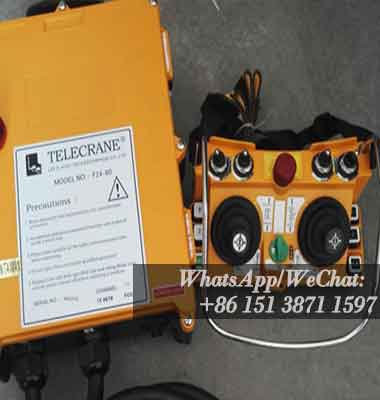

Mini hoist crane remote control
Effective distance: 150m
Operating temperature: - 10 ℃ to + 60 ℃
Product performance: 20 single speed key, can add handle, 1 emergency switch, 1 start key, control distance 100m, protection grade IP65, use temperature - 35 ℃ to + 80 ℃, multiple security design Hamming code and 32-bit non repeated identification code, reinforced plastic shell, widely used
Advantages of using radio controls
Radio controls for overhead crane systems had a low acception about 20-30 years ago. They were costly, and they had a lot of interference difficulties, which produced control concerns, resulting in decreased productivity and irritation for the end-user.
The functioning of the transmitter and receiver has substantially increased over time, making them a stable and trustworthy alternative for managing an overhead crane system. Furthermore, when wireless and radio control technologies grew more common, the cost of these remote systems dropped dramatically, making them a more cost-effective alternative and more comparable to pendant control systems.
Radio controls are battery-operated and can be portable or constructed in a "bellybox" manner, with the user clipping it to their belt or attaching it to a harness or shoulder strap. With different speed options and straightforward controls, both kinds can be compact, lightweight, and ergonomically constructed.
The primary benefit of employing a radio control for an overhead crane is that it eliminates the need to be attached to the crane via cab controls or pendant controls. Because the operator does not have to be close to the weight in order to lift, position, or lower it, radio controls can assist safeguard them from dangers such as:
- Radiation
- High heat or hot metals
- High voltage / electric shock
- High humidity vapor, smoke, or chemical exposure
Not only will the operator be able to operate safely on the floor away from potential hazards, but they will also have a better vantage point from which to perform the lifts. Because the operator does not have to walk alongside the load as it moves along the crane bay, radio controls keep the operator safe from trip and fall dangers such as barriers on the floor, workers, and other gear or equipment in use. They're also perfect for higher duty classifications,when the remote control crane is required to run up and down the runways more frequently and at a faster rate.
One of the cost-cutting advantages of using radio controls to operate a crane is that the operator has better visibility. You no longer need a team of two or three people controlling a crane from the cab and the floor to raise, move, and lower cargo by hand signals because just one operator is necessary to manage the crane from the ground. Better visibility can also aid with faster load placing and damage management since the operator can better evaluate the load and clearing obstructions from the ground.
Advanced developed radio controls can also offer diagnostics and data to a crane operator or a service professional who is servicing or inspecting an overhead crane on site. These sophisticated radio systems can provide information on:The weight on the hook, the number of picks or hooks made, and the diagnostics or fault codes for faults requiring repair are all driven by runtime consumption.
A crane service specialist can extract information directly from the radio control in the event of an issue or fault code that requires maintenance, rather than needing to climb up on a lift to rummage around and identify the source of the problem.
Limitations of using radio controls
For heavy-duty cranes that aren't utilized frequently, radio crane controls aren't suggested. The reason for this is that the controls are battery-powered, and there's a greater possibility that the batteries will be dead or not fully charged when the crane is needed.
Because these controls rely on disposable or rechargeable batteries, they must be examined or replaced on a regular basis, which can cause hassles for the operator and have an impact on productivity if not maintained properly.
Another downside of utilizing a radio control to operate an overhead crane is that, as a handheld device, it is more vulnerable to damage. Even though it's built of durable plastic and rubber, it can still be damaged and lose functioning if dropped frequently.
There are several settings that produce their own radio waves that can interfere with the operation of an overhead crane, however they are uncommon. A facility that performs induction heating or induction welding techniques is an example. The radio waves generated during these operations may interfere with communication between the transmitter and receiver of the radio.
Finally, because the transmitter is not connected to the crane, it is vulnerable to being misplaced if a central storage location is not established ahead of time.
Get your crane remote control
The operator holds a wireless remote transmitter with a set of buttons or levers, or it is hooked onto a harness or belt worn by the operator. A radio signal is sent from the distant transmitter to a reception unit positioned on the crane. This unit converts the signal into electrical energy, which is then sent on to the crane's intermediate relay unit, which activates the proper contact to move the crane up and down the runway, move the hoist or trolley side to side, and raise or lower the hook. To learn more, please contact us via WhatsApp/WeChat: + 86 151 3871 1597 or send us a message using the form below.
Main Projects
Related Products

Latest project
32/5 Ton Overhead Crane Sale in India: Case Study
Free consultation to Confirm Parameters & Specifications and Get
Latest Crane Price & Crane Rate.
- Types of overhead cranes : _______?
- Optional: Overhead travelling crane, goliath gantry crane,Slewing jib crane, Single girder or double girder crane,small portable crane or kbk crane, etc.
- Capacity of overhead crane: _______?
- Optional: 0.25ton, 0.5 ton, 1 ton, 2 ton, 3ton, 5 ton, 10 ton,15ton, 20ton, 25 ton, 30ton,35ton, up to 550ton, etc.
- Crane span & lifting height : _______?
- Crane travelling length : _____?
- Control of overhead crane:_______?
- Optional: pendant/ remote/cabin control
- Voltage supply of overhead crane:_____?
- Eg,: 380V50/60HZ,3Phase or others,etc.
- Application/usage of crane:_______?
- Eg,: Steel mill, ,injection mold, cement,stone, concrete,granite, general manufacturing, etc.
Just leave a message via the contact form and our hoist and crane engineer will contact you with in 24working hours.
Get In Touch
